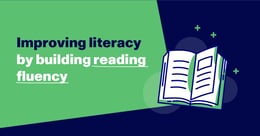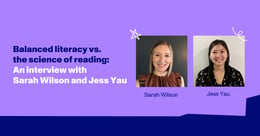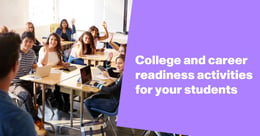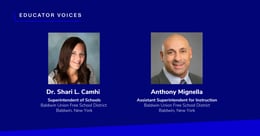
The path forward: An updated plan for academic success in 2023
Three years ago, Paper outlined a plan to close the educational equity gaps in schools. We knew then that the path to success would be guided by partnering and collaborating with students, teachers, and school leaders to collect feedback, test new products, and continually iterate and improve our platform.
Since that time, Paper has grown exponentially, and our countless conversations with schools revealed that everything a student does and learns throughout their K-12 experience should help prepare them to succeed in life.
Every student’s path is individual and unique throughout their academic journey and after graduation. To give students the resources they need to excel, we needed to create a platform capable of being integrated into existing school systems and easy for students to access inside and outside the classroom.
The problem is that most schools are focused on preparing students for college. However, the number of recent high school graduates enrolling in two- or four-year college programs has been steadily declining for nearly a decade and reached a 10-year low of 61% in 2021.
In fact, the majority of high school graduates in the U.S. are not enrolling in four-year universities, and less than 40% ever complete a bachelor's degree. In Mississippi, only 24% of students will graduate from a four-year college. In Massachusetts, the state with the highest college graduation rate, that number is only 47%.
The data is clear, we are poorly preparing our students for life after graduation. This is a double-sided issue as well. Not enough students are going to and graduating from four-year colleges, and students who do not plan to enroll in college are not getting the support they need to excel in their careers.
There is no easy solution for fixing these issues. But, with the proper support, we can give all students the resources to reach their full potential and become successful, motivated, and confident contributors to society.
Phase 1 of Paper’s platform development focused on providing on-demand tutoring to millions of students. To be successful, that support needed to be:
- High quality
- Easily accessible
- Affordable
- Scalable
Tutoring is the hardest part of the student success journey to solve at scale. Supplying enough tutoring in an affordable manner is a challenge most schools face. That meant Paper had to first build an effective and scalable tutoring platform, which required significant investment and attention.
Tutoring was the natural entry point to developing deep relationships with schools and better understanding the needs of students. But tutoring was only meant to be the first step to building a complete Educational Support System (ESS). Our purpose has always been much more expansive.
Paper’s purpose is to boost the confidence of students on their journey of learning. When a student's story changes from struggle to success, from self-doubt to self-worth, we win together.
Last year, we began work on Phase 2, integrating a wider variety of learning tools into one platform and establishing a learner profile that allows students to personalize their learning experience and explore a wider variety of postsecondary pathways.
Success in K-12 education should create the widest and deepest range of opportunities for students after graduation. Using feedback from millions of students, Paper identified three critical areas of education that need to be addressed.
Literacy and writing: Statistics show that kids who engage in reading or reading exercises 20 minutes a day are likely to score better than 90% of their peers on standardized tests. Despite this fact, nearly 68% of America’s fourth graders read below proficiency level, and 82% of those children are from families with fewer resources available.
Confidence in mathematics: Studies show a strong connection between middle school math results and graduation rates. One study of 13,000 students discovered that 81% of students who failed a math course in sixth grade also failed to graduate high school on time. Furthermore, high school math level is a strong predictor of student achievement in secondary and postsecondary schooling. It is no surprise that over 93% of adults experience some level of math anxiety.
Career exploration and preparation: 85% of the jobs that will be needed in 2030 didn’t exist in 2018. With a rapidly evolving economy and job market, exposing students to career opportunities that meet their personalized interests, strengths, and ambitions is critical.
We used these critical areas—literacy, math skills, and career readiness—to re-imagine our ESS to better serve all students. Paper’s ESS is now organized into learning tools for support, practice, and career and college readiness, all intended to create better opportunities for students.

Support: This starts with our Live Help and Review Center offerings. Our ability to deliver multilingual tutoring in over 200 K-12 subjects and feedback on any writing assignment—provided by highly qualified educators—is unmatched. Making these services more accessible is an ongoing priority as well. We recently added accessibility customization features, new language support, and improved mobile access. Now, all students can get help no matter when, how, or where they need support.
Practice: Practice is how you improve—at anything. Decades of data show that developing strong reading, writing, and math skills comes from repeated practice. Paper Missions is our gamified learning area that allows students to practice daily math skills in a fun, low-pressure environment. Paper Reading (formerly known as Readlee) is our gamified AI reading practice. Developed by teachers and Harvard researchers, Paper Reading grew from our acquisition of the award-winning Readlee. As students complete missions or reading goals, it informs their profile and helps the student, their classroom teacher, and our tutors better understand their strengths and weaknesses.
Career and college readiness: Last year, we acquired MajorClarity, the leading career and college readiness (CCR) tool designed for today’s students. This acquisition accelerated and expanded our ability to help students prepare for life after school, and it creates a CCR Learner Profile that draws on the insights from our existing CCR offerings, as well as our support and practice tools. The integrated CCR platform provides academic advising for all learners—whether they intend to pursue a technical certification, a college degree, an internship or apprenticeship, join the military, or move directly into the workforce. It also includes customized academic pathways, college application management, and workforce micro-credentialing.
Opportunity: All of these focus areas—support, practice, and CCR—lead to providing students with more opportunities. Our success here will be measured by a student’s readiness level for life after graduation. No matter what a student wants to do next—college, trade school, enter the workforce, or anything else imaginable—Paper’s goal is to make them better prepared for life.
The path to success begins the first day a student walks into a classroom and continues through graduation. Now Paper’s ESS can help students succeed at every step on the path.
When we started Paper, we knew earning our seat at the table would be difficult. The concept of a virtual ESS that serves all K-12 students’ needs was a bold undertaking. Change can be difficult, and there are no short-term solutions to the challenges facing modern education. Today, we believe we are on the path to providing those solutions.
Paper’s team is dedicated to working with our school partners to overcome these challenges and create a better support system for today’s students. I am excited to see what we accomplish together and how we evolve our vision and purpose in 2023.
Philip Cutler
Co-Founder & CEO
Paper






